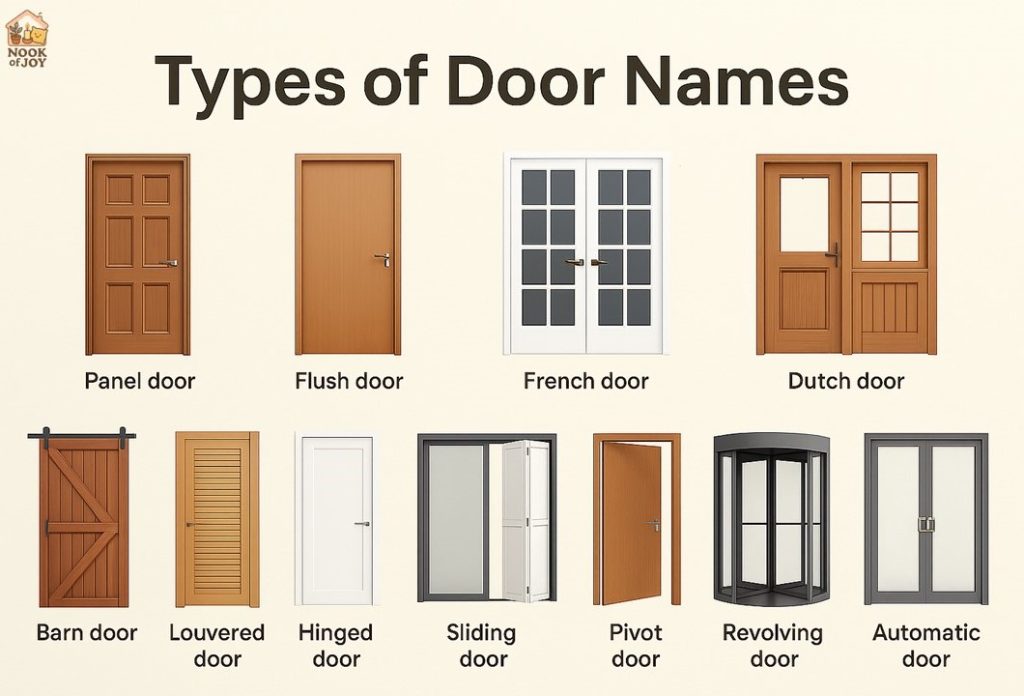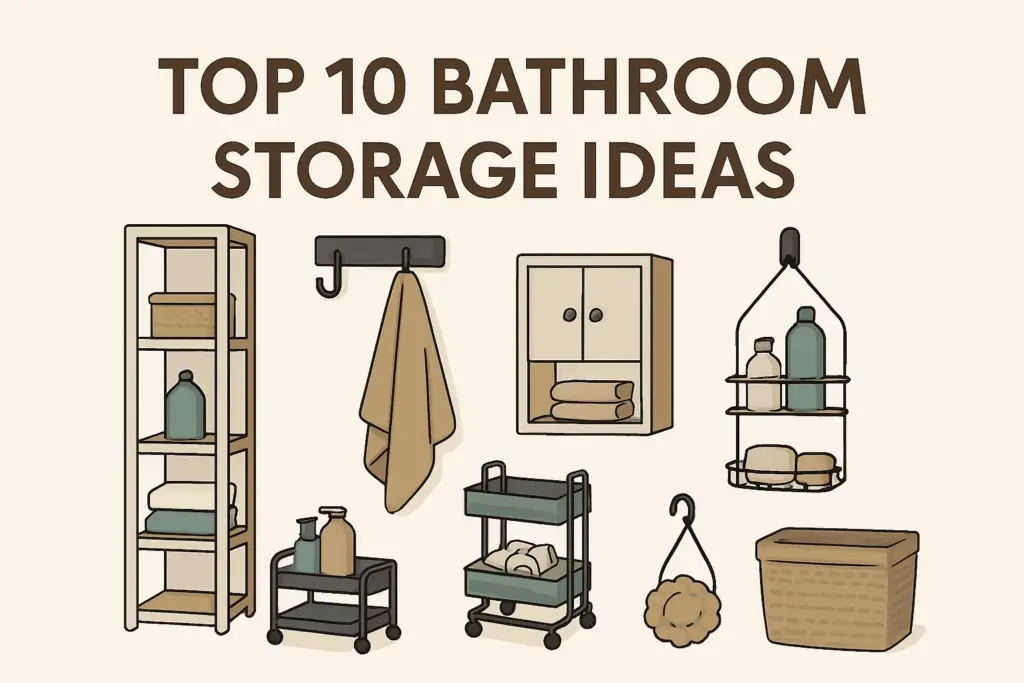
Types of Door Names: Overview
Doors are not just for entering or exiting—they also provide security, privacy, style, and help keep rooms insulated. With numerous types of doors available, understanding their names and classifications aids in selecting the right one for your space. This guide offers a comprehensive overview of door names, categorized by design, material, mechanism, location, and function.
Types of Doors Based on Design
1. Panel Door: A classic door design featuring rectangular panels, commonly available in 2, 4, or 6 panels. Found in most residential homes, panel doors are often made of wood and can be solid or hollow.
2. Flush Door: A smooth, flat surface with no panels or ornamentation. These are widely used in modern interiors and often come with a plywood or MDF finish over a wooden frame.
3. French Door: People often use double doors with large glass panels for patios or balconies. It lets sunlight in and makes the space look bigger.
4. Dutch Door: A horizontally split door that allows the top half to open independently from the bottom. Popular in country-style kitchens or nurseries for ventilation while keeping pets or kids contained.
5. Barn Door: A sliding door, often with visible hardware, is inspired by traditional barns. It adds a rustic touch and helps modern interiors save space.
6. Louvered Door: Features horizontal slats (louvers) for ventilation. Commonly used in closets, laundry rooms, or utility areas.
Door Names Based on Material
1. Wooden Door: The most traditional and versatile material. Available in solid wood (like teak, oak, mahogany) or engineered options. Offers great insulation and aesthetics.
2. Glass Door: Fully or partially made of tempered or frosted glass and often framed with metal or wood, they are used in modern homes and offices to enhance openness.
3. Steel Door: Provides strength and security. Commonly used in commercial buildings and main entrances where durability is crucial.
4. Aluminum Door: Lightweight, corrosion-resistant, and often found in commercial settings, such as office cabins or shop fronts.
5. Fiberglass Door: Resistant to warping and moisture. Mimics the look of wood and is ideal for humid or coastal regions.
6. PVC or UPVC Door: Affordable, waterproof, and low-maintenance. Widely used in bathrooms, balconies, and kitchens.
Door Names Based on Mechanism
1. Hinged Door: The most basic and common type. Hinged on one side and swings open in one direction—either inwards or outwards.
2. Sliding Door: Operates horizontally by sliding along a track. Suitable for balconies, wardrobes, and small spaces.
3. Folding Door / Bi-Fold Door: Consists of multiple panels that fold onto each other. Used for patios, closets, or as room dividers.
4. Pivot Door: It turns around a central point instead of swinging on side hinges. Offers a contemporary look and a smooth opening motion.
5. Revolving Door: Commonly used in commercial buildings, these rotate around a central axis and reduce heat loss.
6. Automatic Door: Sensor-based doors that open and close automatically. Found in malls, hospitals, and airports.
Door Names Based on Location
1. Front/Main Door: The primary entrance door of a home or building. These doors are usually made of wood, steel, or fiberglass and are stronger and heavier for better security.
2. Back Door: Leads to the backyard or service area. Often simpler than the front door.
3. Interior Door: Connects different rooms within a house. Often lightweight, like flush or panel doors.
4. Bathroom Door: Usually moisture-resistant, often made of PVC or plastic laminate.
5. Garage Door: Large doors that open manually or automatically. Available in sectional, roll-up, or tilt-up designs.
6. Patio Door: Glass doors leading to an outdoor space typically feature sliding or French-style designs.
Doors Based on Function or Use
1. Security Door: Reinforced doors made of steel or iron, often with grills or mesh. Installed for safety against break-ins.
2. Fire-Rated Door: Built to resist fire for a set time, such as 30, 60, or 90 minutes. Required in commercial buildings and fire-prone zones.
3. Soundproof Door: Specially constructed with insulation layers to reduce noise. Used in studios, hotels, or home theaters.
4. Trap Door: A hidden or flush door is installed in floors or ceilings, often for storage or access to basements/attics.
5. Screen Door: A mesh-based secondary door that allows air and light while keeping insects out. Common in tropical regions.
Specialty Door Names
| Door Type | Purpose/Use |
| Pocket Door | Slides into a wall cavity—great space saver |
| Saloon Door | Swinging, half-height doors for bars/kitchens |
| Accordion Door | Expands and folds like an accordion—used for partitions |
| Bulletproof Door | High-security doors with ballistic resistance |
| X-Ray Shielded Door | Found in hospitals near radiology units |
Choosing the Right Door
When choosing a door, consider the following:
- Purpose: Entry, security, ventilation, aesthetics?
- Material: Choose based on climate, use, and durability needs.
- Mechanism: Swinging, sliding, folding—depending on space.
- Maintenance: Wood requires more care; PVC is low-maintenance.
- Budget: Costs vary widely across materials and designs.
Final Thoughts
Doors are a vital component of architectural design and everyday functionality. Understanding door names—by design, material, mechanism, or purpose—helps you make informed choices when renovating your home, building a new office, or upgrading security. From elegant French doors to sturdy steel security doors, each type serves a distinct purpose in shaping your environment.

